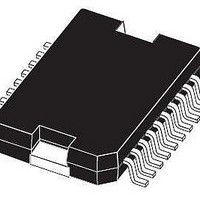L9949 STMicroelectronics, L9949 Datasheet - Page 13

L9949
Manufacturer Part Number
L9949
Description
IC DRIVER DOOR ACTUATOR PWRSO-20
Manufacturer
STMicroelectronics
Type
Door Actuator Driverr
Datasheet
1.L9949TR.pdf
(20 pages)
Specifications of L9949
Applications
Automotive
Current - Supply
7mA
Voltage - Supply
7 V ~ 28 V
Operating Temperature
-40°C ~ 150°C
Mounting Type
Surface Mount
Package / Case
PowerSO-20 Exposed Bottom Pad
Product
Half-Bridge Drivers
Supply Current
20 mA
Mounting Style
SMD/SMT
Lead Free Status / RoHS Status
Lead free / RoHS Compliant
Available stocks
Company
Part Number
Manufacturer
Quantity
Price
Part Number:
L9949TR
Manufacturer:
ST
Quantity:
20 000
L9949
rising edge of the CLK signal and shifted into an internal 16 bit shift register. At the rising edge of the CSN signal
the contents of the shift register will be transfered to Data Input Register (see FIGURE 8).
The SPI uses an internal 16 bit counter which will be reset at the rising edge of the CSN signal. Only the first 16
bits of the data input DI will be relevant. If more than 16 bits are transfered the trailing bits will be ignored.
Serial Data Out (DO)
The output driver is activated by a logical low level at the CSN input and will go from high impedance to a low
or high level depending on the status bit 0 (fault condition). The first rising edge of the CLK input after a high to
low transition of the CSN pin will transfer the content of the selected status register into the data out shift register.
Each subsequent falling edge of the CLK will shift the next bit out.
Serial Clock (CLK)
The CLK input is used to synchronize the input and output serial bit streams. The data input (DI) is sampled at
the rising edge of the CLK and the data output (DO) will change with the falling edge of the CLK signal (see
FIGURE 8).
Input Data Register
After the rising edge of CSN the contents of the input shift register will be written to the input data register. De-
pending on bit 0 the contents of the selected status register will be transfered to DO during the current commu-
nication cycle. Bit 1-11 controls the behaviour of the corresponding driver. If bit 12 and bit 13 are zero, the device
will go into the standby-mode. If at least one of both bits are one these bits will be used to control the current
monitor multiplexer. Bit 14 selects the V
lockout mode. If this bit is set, an over- or undervoltage condition at
S
the power supply V
will disable all driver stages until the status bit will be cleared by the microcontroller. Bit 15
S
is used to reset all status bits in both status registers. The bits in the status registers will be cleared after the
current communication cycle (rising edge of CSN).
Status Register
This devices uses two status registers to store and to monitor the state of the device. Bit 0 is used as a fault bit
and is a logical-NOR combination of all other bits in both status registers. The state of this bit can be polled by
the microcontroller without the need of a full SPI-communication cycle (see FIGURE 13). If one of the overcur-
rent bits is set, the corresponding driver will be disabled. The microcontroller has to clear the overcurrent bit to
enable the driver. If the thermal shutdown bit is set, all drivers will go into a high impedance state. Again the
microcontroller has to clear the bit to enable the drivers. The behaviour of the device in case of an over- or un-
dervoltage condition will depend on the V
lockout bit (bit 14) in the input data register. If bit 14 is cleared, the
S
device will reactivate the drivers if the power supply V
returns to normal operating range. In this case no inter-
S
action from the microcontroller is needed.
Test Mode
Due to the current limitations of a single bond wire the output stages OUT1, 2 and 6 need two bond wires in
parallel. For the full output current driving capability it is necessary to check that both bond wires are connected
correctly to the lead frame. Therefore the drivers and DMOS-transistors of the outputs OUT1, 2 and 6 are split-
ted into two independet stages, one for each bond wire (see FIGURE 6.4). In normal operating mode the splitted
outputs are connected in parallel. In the test mode bit 5 and 6 of the input data register select the A-driver, bit 7
and 8 the B-driver. If all four bits (5 - 8) are switched to high level, no driver will be activated. For all combinations
beside both high of bit 5 and 6 or bit 7 and 8 the output stages OUT3 and OUT4 are controlled like in normal
operating mode. In any case the output stages are protected against shoot through current. Furthermore the
inputs CLK and DI are connected by an OR to the output DO for testing the threshold voltages and the hyster-
esis. The input CLK can be tested by clamping the input DI to low level and vice versa.
13/20













